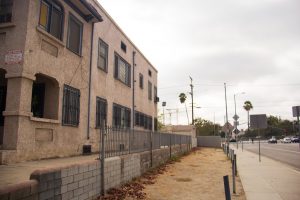Flower Drive tenants may face eviction with hotel and student housing project
When Monica Tacanga stares out through her steel screen doors at the street where she grew up, she sees a neighborhood in constant flux. From notorious gang activity to a new freeway carrying smog and dust, the 3900 block of Flower Drive has seen it all, according to Tacanga. Eight historic multi-story buildings, constructed in 1922 during the era of streetcars, have stood there all this time.
“It’s three generations living here,” Tacanga, 40, said. Her parents moved into the one-bedroom apartment in the 70s, and raised her on the block. Tacanga, a single mother, would raise her daughter in the same unit, on the same street. Two years ago, her father passed away in the apartment.
Tucked between an empty parking lot and the 10 Freeway, the block of residential buildings half a mile south of campus is home for families like Tacanga’s, with multigenerational, decades-long ties to the community.
But soon, she and dozens of other residents may have to leave as developers prepare to demolish their buildings to make way for hundreds of new residences — including housing targeted to USC students.

Facing eviction · Elyse Valenzuela, 26, and her family have lived on Flower Drive for 27 years. (Terry Nguyen | Daily Trojan)
Since 2014, real estate development and investment firm Ventus Group has supported construction of a mixed-use development on the 3900 block. The Fig Project, which is currently under review by the Los Angeles City Council, will take up 4.42 acres, including a 7-story hotel, 222 units of student housing, 186 units of residential housing and a commercial retail space. Under the group’s current plan, outlined in a draft environmental impact report to the city, the project will demolish 32 rent-controlled housing units, which are also designated historic buildings by the state of California.
“We really are going to have some concerted effort to … enable low-income people to stay in the city,” said Cynthia Strathmann, executive director of Strategic Actions for a Just Economy, a nonprofit that advocates for tenant and community rights. “The Fig Project is really emblematic of that. You have historic buildings with low-income people, mostly of people of color who have lived there for a long time.”
Ventus Group declined to comment on the tenants’ situation to the Daily Trojan. Since hearing about the project two years ago, SAJE has held community meetings and workshops to educate tenants about housing rights and the processes leading up to their potential eviction.
There is no certain date on the groundbreaking of the project, but the development is on schedule for Fall 2019, said John David Booty, Ventus Group’s executive vice president. He added that the developer aims to begin a public hearing process with the city within the next several months.
Ventus Group has had periodic conversations with the University, and the project’s proposal came even before the USC Village was announced, according to Booty.
“We felt there was a great demand for student housing around USC, and that still holds true given the occupancy in most of the student housing,” Booty said.
Living in uncertainty
Tacanga said she is desperate for an outcome other than eviction or demolition.
“I got so desperate one day that I’m like, I just want to go straight to the developer’s face and tell them, ‘What the hell are they doing?’” Tacanga said, her voice shaking. “Come and see for yourself — don’t send your representatives.”
But she is not alone in her desperation. For most residents on the block, English is not their native language, and some are elderly, disabled or living on fixed income, according to Maria Ochoa, a SAJE organizer.
The Fig Project will contain 82 units of affordable housing, out of 186 units, for families making less than 80 percent of the Los Angeles County median income. Households making less than $54,000 a year would be eligible, but South Central Los Angeles’ median income, at $31,000, is markedly lower than that of the county’s.
But Ochoa said residents are still worried about finding a place to live if they are evicted, particularly while the new affordable housing units are under construction.
“In this rental climate where rents are extremely expensive and choice spaces that are healthy and inhabitable are [difficult to find] for families who are low-income, it’s not a great time looking for spaces,” Ochoa said.
For some tenants, the cost of moving is too steep to consider.
“As poor people, we say without money, we can’t do anything,” Tacanga said. “Right now, if they were to come and tell us to leave, me, my mom and my daughter would be out on the street.”
Her family of three lives from paycheck to paycheck, in a one-bedroom apartment with a kitchen, dining space and living room, for around $500 a month — a price they are unlikely to find anywhere else.
The average monthly rent for a one-bedroom in Los Angeles is $2,068, while a studio apartment costs $1,622, according to a Rent Cafe report.
Vanessa Anguiano, Tacanga’s neighbor and close friend, also admitted her family would not be able to afford current housing rates. Anguiano’s mother has been submitting applications to live in a retirement home to ease their financial burden if the evictions become a reality, but the process can take years, she said.
“I’ve been searching on Zillow and the cheapest thing in this area within 10 miles is like $1,200 [per month] for a studio or maybe a one-bedroom,” Anguiano said. “There are hardly any available.”
SAJE is helping to advocate for collective bargaining power among the tenants, although the organization is not directly representing them in future negotiations with the developers or property owners.
During a community meeting in late August, Ochoa stood in front of about 15 tenants, speaking animatedly and switching between English and Spanish.
“No matter what your language, your voice is powerful,” she said.
Ochoa encouraged the tenants to avoid taking private “cash for keys” buyouts from the landlord to increase their leveraging power as a group. If evicted, tenants are entitled to relocation assistance fees under the Ellis Act, a state provision that allows landlords to remove tenants if the property is leaving the rental market — in this case by demolition. Relocation fees are given out by the city to each unit, based on factors such as income levels, duration of stay, family size and age.
The tenants believe they should receive just compensation for leaving their homes that will allow them to have a comfortable transition. Elyse Valenzuela, a 26-year-old-tenant, is one of the representatives who will advocate for the community when the time for negotiations comes.

History of generations · Monica Tacanga, 40, grew up on Flower Drive, where she is now raising her daughter. (Terry Nguyen | Daily Trojan)
The relocation assistance amounts listed by the city are minimum amounts, and are guidelines in case a private agreement is reached between a tenant and developers. Valenzuela hopes the residents can reach an equitable financial agreement based on each household’s circumstance.
“At the end of the day, we’re all in this together, so we might as well join forces,” Valenzuela said. “Every family’s situation is different, but everyone has stayed [to negotiate] with SAJE.”
Some tenants have invested in personal renovations for their units, making them unwilling to leave a place they’ve spent time and money fixing up. Valenzuela’s family, who has lived there for 27 years, had renovated their hardwood floors, painted the walls white and added new windows to modernize the unit.
A working-class history
While tenants have personal and financial reasons for wanting to stay on Flower Drive, the West Adams Heritage Association’s goal is to preserve the historic designation and conservation of the buildings on the 3900 block. Demolition of the buildings is not an ideal situation for the organizations or the city, said association member Jim Childs.
The 3800 and 3900 blocks of Flower Drive are under a historic preservation overlay zone, which was designated by the state of California in 2008, according to public land records.
“It’s an assault on historic preservation,” Childs said. “They don’t have to do this, they’re choosing to do this … The development can happen without the loss of historic stock.”
As an example, Childs cited the 3800 block of Flower Drive, where developers are also seeking to build new structures. But there, their plan is to build around the historic houses, preserving their exteriors rather than demolishing them.
While historic preservation status might not prevent tenant displacement, Childs is hopeful that at least the buildings’ exteriors will remain. A key factor in what makes certain buildings historical is their social significance, which requires people to inhabit them. According to Childs, Flower Drive is one of the few preserved affordable housing structures in the city.
“It doesn’t have to be grand to be part of the narrative of the history of Los Angeles,” Childs said.
Many tenants did not realize their homes had historic value, but they did recognize the sense of community and unique social interactions the neighborhood provided them.“A lot of the details in the apartment, you can feel the history — that it’s a part of us,” said resident Shaquinta Prince, 32. “It concerns me that anything in L.A. they want to tear … down instead of repurposing these buildings, or refurbishing them and investing into them.”
Kate Sequeira contributed to this report.


